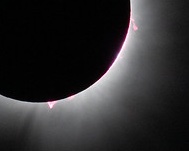A total solar eclipse, like the one that was visible over North America on April 8, 2024, is one of the most magnificent events we humans can observe from Earth. Why? Because for a brief moment it vividly shows us our place in the universe. We can watch as the moon moves in front of the sun, as the sunlight dims, as the sun "disappears" for a short time in the middle of the day and as the moon then continues on its path.
We were in Texas on April 8, 2024 to observe the total solar eclipse. In conversations with acquaintances, friends or strangers, we often heard that many perceived the chance to see a solar eclipse "on their own doorstep" as nothing special at all. A misconception! In this report, we explain what is so great about such an event. Experiencing a total solar eclipse is great, a little eerie and, for some, spiritual. The risk of addiction is high: anyone who has ever seen a total solar eclipse will want to repeat the experience.
What you can experience during a solar eclipse
Before and during a total solar eclipse, you can experience many sensory impressions and make observations that you would otherwise not be able to see.
A very peculiar light
During a solar eclipse, the moon moves further and further in front of the sun and gradually obscures its light. This can be clearly seen in the minutes shortly before totality, before the moon completely covers the sun. The human eye perceives that the light changes in the middle of the day. The intensity decreases, the light has a different hue. If you didn't know that a solar eclipse was taking place, this change in light could be very eerie. The strange light is one of the most striking features of a solar eclipse (apart from the darkness during totality).
The corona of the sun
 Photo: Evans Caglage, Dallas, Texas
Photo: Evans Caglage, Dallas, Texas
The corona is an impressive sight during a total solar eclipse. This is the hot, thin outer atmosphere of the sun, which is only visible to the eye during a total solar eclipse. Its temperature is around two million degrees Celsius.
The expansion of the corona depends on the 11-year cycle of the sun's magnetic activity. During the so-called solar maximum, magnetic activity is high and the corona is large. This was the case on April 8, 2024, as we are currently in the middle of a fairly strong solar maximum.
Prominences: When the sun has pink spot
Between the visible solar disk and the corona lies the chromosphere with a temperature of 10,000 Kelvin. The chromosphere contains so-called prominences. These are hot gases that float in the solar atmosphere due to magnetic fields. Prominences usually consist of hydrogen gas, which glows in a beautiful pink to reddish color. During a total solar eclipse, the moon covers the sun's disk and gives us a rare glimpse of the sun's chromosphere.
During the solar eclipse on April 8, the sun showed a huge prominence in the south. At first glance, this looked like a small pink pimple. It is rare to see a prominence with the naked eye. Most can only be seen with binoculars. This prominence was about the size of the planet Saturn, which is why it was visible to the naked eye.  Photo: NASA / Keegan Barber
Photo: NASA / Keegan Barber
The shadow of the moon
If you are in an open field during a solar eclipse when the sky is clear, you can see the core shadow of the moon racing towards you at a speed of 2,500 km/h. This racing shadow can look quite menacing - and impressive. This speeding shadow can look quite menacing - and impressive.
A sunset - but in 360 degrees on the horizon
After a normal sunset, you can see a glow of light on the western horizon. During the total solar eclipse, we saw this glow all around us on the horizon. Another difference to a daily sunset: after the sun has set, the sky is still relatively bright for some time. During a solar eclipse, the moment the moon covers the sun, it is as if someone has turned off the sun's light switch.
Caution: Only observe the sun with special glasses
Please never look at the sun without special eye protection for observing the sun. There are glasses for observing a solar eclipse. They have a film that protects your eyes. Only during the short phase of a total solar eclipse, when the moon completely covers the sun, can you look directly at the sun.
Please also take care when using a camera, telescope or binoculars: Always use a special solar filter placed over the front of the optics or in front of the lens. You can get serious eye damage if you look at the sun with a camera, binoculars or telescope without a special filter.
If you have the opportunity to observe a total solar eclipse, seize it! Did you know? Modern solar telescopes and instruments can create an artificial solar eclipse so that the sun's corona can be studied. From such systematic studies, researchers can learn a lot about the physical processes that lead to solar storms. Research into the sun is one of the focal points of research at the Thuringian State Observatory.
Author: Artie Hatzes


